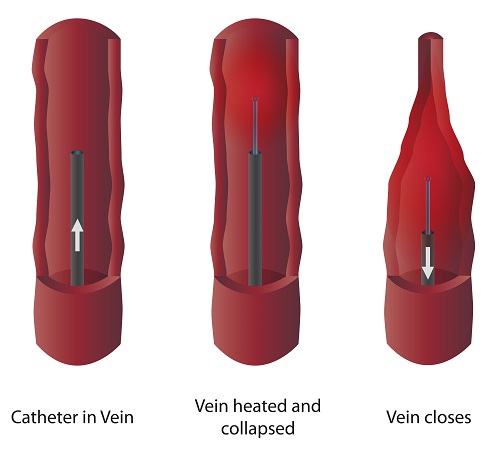Varicose vein laser ablation is the most effective and least invasive treatment for patients with varicose veins in the legs and is thus quickly becoming the gold standard for treatment of varicose veins.
 Some people who have varicose veins choose to have the procedure to prevent further deterioration while others choose to have the procedure for cosmetic reasons to improve how their legs look.
Some people who have varicose veins choose to have the procedure to prevent further deterioration while others choose to have the procedure for cosmetic reasons to improve how their legs look.
About the Procedure
Endovenous Laser Treatment uses laser energy, which is simply a highly concentrated beam of light to deposit energy in the vein wall and thus causes shrinkage and closure. In the hands of a skilled physician, lasers offer far less risk for complications than conventional surgery. During the procedure, a thin laser fiber is inserted into the damaged vein through pinpoint entry site in the skin. A laser light is emitted through the fiber as it is being pulled back through the targeted vein. The targeted tissue reacts with the light energy, causing the vein to close and seal shut. The closed veins only handle less than five percent of the body’s blood flow and are superficial. The blood is automatically routed to other, healthy veins.
Benefits of Vein Ablation Treatment
If varicose veins cause few symptoms, Dr. Tilara may simply suggest making lifestyle changes. If a patient’s symptoms are more severe, he may recommend one or more medical procedures to remove varicose veins or close them completely. Removing or closing varicose veins usually doesn’t cause problems with blood flow because the blood starts moving through other veins.
Suggested Lifestyle Changes
Lifestyle changes often are the first treatment for varicose veins. These changes can prevent varicose veins from getting worse, reduce pain, and delay other varicose veins from forming. Lifestyle changes include the following:
- Avoid standing or sitting for long periods of time.
- When sitting, avoid crossing the legs.
- Do physical activities to improve muscle tone.
- Lose weight if overweight (or obese) to improve blood flow and ease venous pressure.
- Avoid wearing tight clothes, especially those that are tight around the waist, groin (upper thighs), and legs. Tight clothes can make varicose veins worse.
- Avoid wearing high heels for long periods. Lower heeled shoes can help tone calf muscles. Toned muscles help blood move through the veins.
- Dr. Tilara may recommend compression stockings. These stockings create gentle pressure up the leg. This pressure keeps blood from pooling and decreases swelling in the legs.







